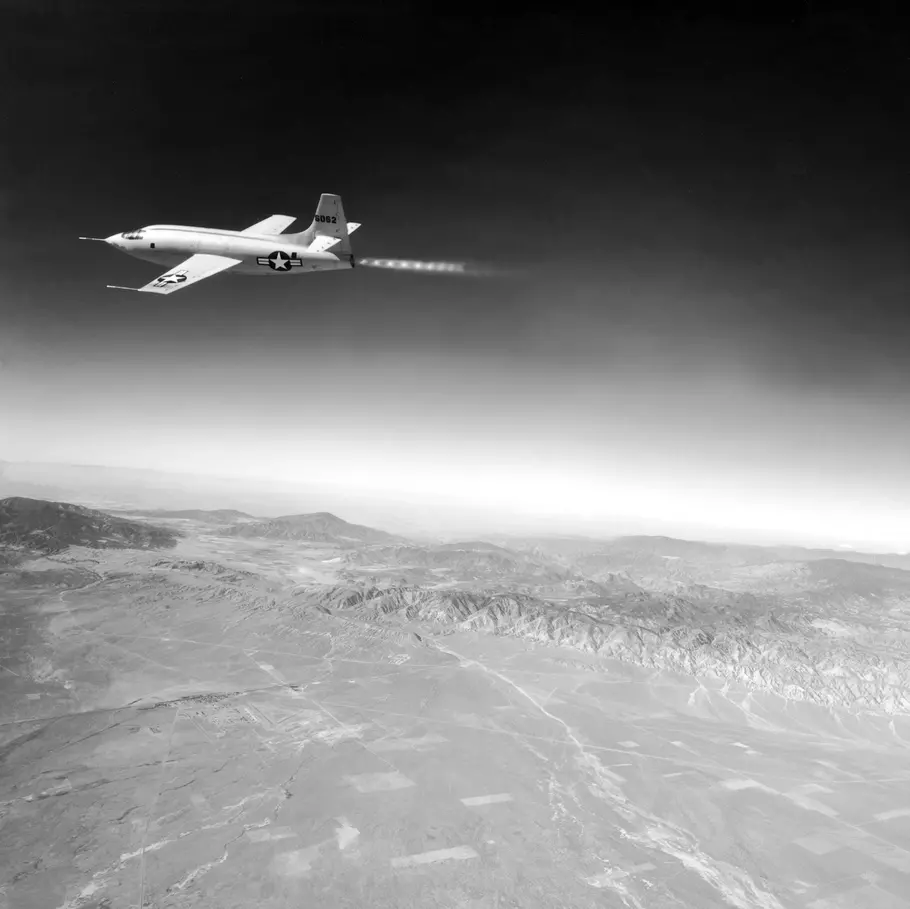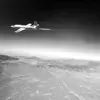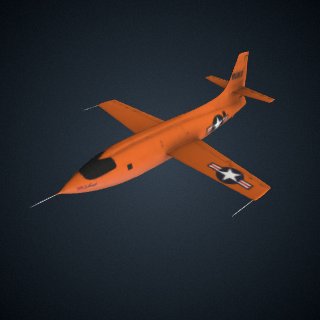On October 14, 1947, flying the Bell XS-1 #1, Capt. Charles 'Chuck’ Yeager, USAF, became the first pilot to fly faster than sound. The XS-1, later designated X-l, reached Mach 1.06, 700 mph, at an altitude of 43,000 feet, over the Mojave Desert near Muroc Dry Lake, California. The flight demonstrated that aircraft could be designed to fly faster than sound, and the concept of a ‘sound barrier" crumbled into myth.
The XS-1 was developed as part of a cooperative program initiated in 1944 by the National Advisory Committee for Aeronautics (NACA) and the U.S. Army Air Forces (later the U.S. Air Force) to develop special manned transonic and supersonic research aircraft. On March 16, 1945, the Army Air Technical Service Command awarded the Bell Aircraft Corporation of Buffalo, New York, a contract to develop three transonic and supersonic research aircraft under project designation MX-653. The Army assigned the designation XS-1 for Experimental Sonic-i. Bell Aircraft built three rocket-powered XS-1 aircraft.
The National Air and Space Museum now owns the XS-1 #1, serial 46-062, named Glamorous Glennis by Captain Yeager in honor of his wife. The XS-1 #2 (46-063) was flight-tested by NACA and later was modified as the X-1 "Mach 24" research airplane. (The X-1 E is currently on exhibit outside the NASA Flight Research Center, Edwards, California.) The X-1 #3 (46-064) had a turbopump-driven, low-pressure fuel feed system. This aircraft, known popularly as the X-1-3 Queenie, was lost in a 1951 explosion on the ground that injured its pilot. Three additional X-1 aircraft, the X-1A, X-1B, and X-1D, were constructed and test-flown. Two of these. the X-1A and X-1D, were also lost, as a result of propulsion system explosions.
The two XS-1 aircraft were constructed from high-strength aluminum, with propellant tanks fabricated from steel. The first two XS-1 aircraft did not utilize turbopumps for fuel feed to the rocket engine, relying instead on direct nitrogen pressurization of the fuel-feed system. The smooth contours of the XS-1, patterned on the lines of a .50-caliber machine gun bullet, masked an extremely crowded fuselage containing two propellant tanks, twelve nitrogen spheres for fuel and cabin pressurization, the pilot’s pressurized cockpit, three pressure regulators, a retractable landing gear, the wing carry-through structure, a Reaction Motors, Inc., 6.000-pound-thrust rocket engine, and more than five hundred pounds of special flight-test instrumentation.
Though originally designed for conventional ground takeoffs, all X-1 aircraft were air-launched from Boeing B-29 or B-50 Superfortress aircraft. The performance penalties and safety hazards associated with operating rocket-propelled aircraft from the ground caused mission planners to resort to air-launching instead. Nevertheless, on January 5,1949, the X-1 #1 Glamorous Glennis successfully completed a ground takeoff from Muroc Dry Lake, piloted by Chuck Yeager. The maximum speed attained by the X-1 #1 was Mach 1.45 at 40,130 feet, approximately 957 mph, during a flight by Yeager on March 26, 1948. On August 8,1949, Maj. Frank K. Everest, Jr., USAF, reached an altitude of 71,902 feet, the highest flight made by the little rocket airplane. It continued flight test operations until mid-1950, by which time it had completed a total of nineteen contractor demonstration flights and fifty-nine Air Force test flights.
On August 26, 1950, Air Force Chief of Staff Gen. Hoyt Vandenberg presented the X-1 #1 to Alexander Wetmore, then Secretary of the Smithsonian Institution. The X-1, General Vandenberg stated, "marked the end of the first great period of the air age, and the beginning of the second. In a few moments the subsonic period became history and the supersonic period was born." Earlier, Bell Aircraft President Lawrence D. Bell, NACA scientist John Stack, and Air Force test pilot Chuck Yeager had received the 1947 Robert J. Collier Trophy for their roles in first exceeding the speed of sound and opening the pathway to practical supersonic flight.


























































